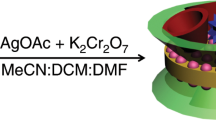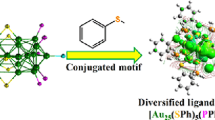Abstract
In this article, we present a facile, direct, synthetic approach of preparing monodisperse [Au25(SePh)18]− nanoclusters in high yield. In this synthetic approach, two-phase Brust-Schiffrin method is used. Both PhSeH and NaBH4 should be added drop-wise to the solution of Au (III) at the same time. The formula and molecular purity of [Au25(SePh)18]−TOA+ clusters are characterized by MALDI-TOF mass spectrometry, NMR and TGA analysis. Furthermore, some critical parameters to obtain pure [Au25(SePh)18]−TOA+ are identified, including the NaBH4-to-Au ratio, the selenolate-to-Au ratio and the temperature. The facile, direct, high yield synthetic method can be widely applied in the theoretical research of Au clusters protected by selenol.
Similar content being viewed by others
References
Brust M, Walker M, Bethell D, Schiffrin DJ, Whyman R. Synthesis of thiol-derivatised gold nanoparticles in a two-phase Liquid-Liquid system. J Chem Soc Chem Commum, 1994, 0: 801–802
Qian HF, Zhu MZ, Wu ZK, Jin RC. Quantum sized gold nanoclusters with atomic precision. Acc Chem Res, 2012, 45: 1470–1479
Maity P, Xie SH, Yamauchi M, Tsukuda T. Stabilized gold clusters: from isolation toward controlled synthesis. Nanoscale, 2012, 4: 4027–4037
Serrano de la Cruz D, Santillana E, Mingo A, Fuenmayor G, Pantoja A, Fernandez E. Improved thin-layer chromatographic determination of phospholipids in gastric aspirate from newborns, for assessment of lung maturity. Clin Chem, 1988, 34: 736–738
Schmid G. Large clusters and colloids. Metals in the embryonic state. Chem Rev, 1992, 92: 1709–1727
Weare WW, Reed SM, Warner MG, Hutchison JE. Improved synthesis of small (d CORE ≈ 1.5 nm) phosphine-stabilized gold nanoparticles. J Am Chem Soc, 2000, 122: 12890–12891
Shichibu Y, Suzuki K, Konishi K. Facile synthesis and optical properties of magic-number Au13 clusters. Nanoscale, 2012, 4: 4125–4129
Gomez S, Philippot K, Colliere V, Chaudret B, Senocq F, Lecante P. Gold nanoparticles from self-assembled gold(I) amine precursors. Chem Commun, 2000, 19: 1945–1946
Kumar A, Mandal S, Pasricha R, Mandale AB, Sastry M. Investigation into the interaction between surface-bound alkylamines and gold nanoparticles. Langmuir, 2003, 19: 6277–6282
Maity P, Wakabayashi T, Ichikuni N, Tsunoyama H, Xie SH, Yamauchi M, Tsukuda T. Selective synthesis of organogold magic clusters Au54(C ≡ CPh)26. Chem Commun, 2012, 48: 6085–6087
Meng XM, Xu Q, Wang SX, Zhu MZ. Ligand-exchange synthesis of selenophenolate-capped Au25 nanoclusters. Nanoscale, 2012, 4: 4161–4165
Zhu MZ, Lanni E, Garg N, Bier ME, Jin RC. Kinetically controlled, high-yield synthesis of Au25 clusters. J Am Chem Soc, 2008, 130: 1138–1139
Zhu MZ, Aikens CM, Hollander FJ, Schatz GC, Jin RC. Correlating the crystal structure of a thiol-protected Au25 cluster and optical properties. J Am Chem Soc, 2008, 130: 5883–5885
Nimmala PR, Dass A. Au36(SPh)23 nanomolecules. J Am Chem Soc, 2011, 133: 9175–9177
Qian HF, Zhu Y, Jin RC. Size-focusing synthesis, optical and electrochemical properties of monodisperse Au38(SC2H4Ph)24 nanoclusters. ACS Nano, 2009, 3: 3795–3803
Qian HF, Eckenhoff WT, Zhu Y, Pintauer T, Jin RC. Total structure determination of thiolate-protected Au38 nanoparticles. J Am Chem Soc, 2010, 132: 8280–8281
Dass A. Mass spectrometric identification of Au68(SR)34 molecular gold nanoclusters with 34-electron shell closing. J Am Chem Soc, 2009, 131: 11666–11667
Jadzinsky PD, Calero G, Ackerson CJ, Bushnell DA, Kornberg RD. Structure of a thiol monolayer-protected gold nanoparticle at 1.1 Å resolution. Science, 2007, 318: 430–433
Qian HF, Jin RC. Controlling nanoparticles with atomic precision: The case of Au144(SCH2CH2Ph)60. Nano Lett, 2009, 9: 4083–4087
Qian HF, Zhu Y, Jin RC. Atomically precise gold nanocrystal molecules with surface plasmon resonance. P Natl Acad Sci USA, 2012, 109: 696–700
Negishi Y, Kamimura U, Ide M, Hirayama M. A photoresponsive Au25 nanocluster protected by azobenzene derivative thiolates. Nanoscale, 2012, 4: 4263–4268
Wu ZK, Jin RC. On the Ligand’s role in the fluorescence of gold nanoclusters. Nano Lett, 2010, 10: 2568–2573
Zhu MZ, Aikens CM, Hendrich MP, Gupta R, Qian HF, Schatz GC, Jin RC. Reversible switching of magnetism in thiolate-protected Au25 superatoms. J Am Chem Soc, 2009, 131: 2490–2492
Yee CK, Ulman A, Ruiz JD, Parikh A, White H, Rafailovich M. Alkyl selenide- and alkyl thiolate-functionalized gold nanoparticles: Chain packing and bond nature. Langmuir, 2003, 19: 9450–9458
Xu Q, Wang SX, Liu Z, Xu GY, Meng XM; Zhu MZ. Synthesis of selenolate-protected Au18(SeC6H5)14 nanoclusters. Nanoscale, 2013, 5: 1176–1182
Huang FK, Horton RC, Myles DC, Garrell RL. Selenolates as alternatives to thiolates for self-assembled monolayers: a SERS study. Langmuir, 1998, 14: 4802–4808
Sato Y, Mizutani F. Formation and characterization of aromatic selenol and thiol monolayers on gold: in-situ IR studies and electrochemical measurements. Phys Chem Chem Phys, 2004, 6: 1328–1331
Weidner T, Shaporenko A, Müller J, Höltig M, Terfort A, Zharnikov M. Self-assembled monolayers of aromatic tellurides on (111)-oriented gold and silver substrates. J Phys Chem C, 2007, 111: 11627–11635
Llave D, Scherlis DA. Selenium-based self-assembled monolayers: The nature of adsorbate-surface interactions. Langmuir, 2010, 26: 173–178
Negishi Y, Kurashige W, Kamimura U. Isolation and structural characterization of an octaneselenolate-protected Au25 cluster. Langmuir, 2011, 27: 12289–12292
Kurashige W, Yamaguchi M, Nobusada K, Negishi Y. Ligand-induced stability of gold nanoclusters: thiolate versus selenolate. J Phys Chem Lett, 2012, 3: 2649–2652
Author information
Authors and Affiliations
Corresponding authors
Rights and permissions
About this article
Cite this article
Song, Y., Cao, T., Deng, H. et al. Kinetically controlled, high-yield, direct synthesis of [Au25(SePh)18]−TOA+ . Sci. China Chem. 57, 1218–1224 (2014). https://doi.org/10.1007/s11426-014-5071-5
Received:
Accepted:
Published:
Issue Date:
DOI: https://doi.org/10.1007/s11426-014-5071-5




